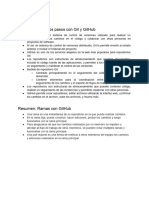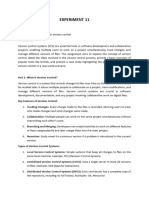Version Control For Git and Github
Uploaded by
newel31882Version Control For Git and Github
Uploaded by
newel31882Version Control Workflow: Git and GitHub for Beginners
What is Git?
Git is a distributed version control system that allows multiple developers to
collaborate on a project while keeping track of changes.
What is GitHub?
GitHub is a cloud-based hosting service for Git repositories that facilitates
collaboration, version control, and project management.
Basic Git Workflow:
1. **Initialize a Repository**:
To create a new repository, run:
```bash
git init
```
2. **Track Changes**:
To track a file or folder, use `git add`:
```bash
git add <filename>
```
3. **Commit Changes**:
Commit the changes you made:
```bash
git commit -m "Your commit message"
```
4. **Push to GitHub**:
Push your local repository to GitHub:
```bash
git push origin main
```
Branching:
- Branches are used to work on separate features without affecting the main
codebase.
- To create a new branch:
```bash
git checkout -b feature-branch
```
- To switch between branches:
```bash
git checkout main
```
Merging:
- Merge changes from one branch to another:
```bash
git merge feature-branch
```
Resolving Merge Conflicts:
- Merge conflicts happen when two developers modify the same part of a file.
- Git will mark the conflicting lines, and you’ll need to manually resolve the
conflict.
- After resolving, mark the conflict as resolved:
```bash
git add <filename>
git commit
```
GitHub Workflow:
1. Fork a repository to create your copy of a project.
2. Clone it to your local machine:
```bash
git clone <repo-url>
```
3. After making changes, push them to GitHub:
```bash
git push origin main
```
4. Submit a pull request for your changes to be reviewed.
Best Practices:
- Write clear commit messages that explain what was changed and why.
- Regularly push your changes to the remote repository to avoid conflicts.
- Use branches for new features and bug fixes, keeping `main` stable.
Conclusion:
Git and GitHub are essential tools for version control and collaboration in modern
software development. Knowing how to use them efficiently will make your workflow
smoother and more productive.
You might also like
- Comprehensive_Git_and_GitHub_Learning_GuideNo ratings yetComprehensive_Git_and_GitHub_Learning_Guide7 pages
- Git Commands For Devops and Cloud 1703998791No ratings yetGit Commands For Devops and Cloud 17039987915 pages
- Introduction to Version Control With GitNo ratings yetIntroduction to Version Control With Git19 pages
- What Is Version Control?: by Ashok KumarNo ratings yetWhat Is Version Control?: by Ashok Kumar10 pages
- Professional Git 1st Edition Brent Laster - Download the full set of chapters carefully compiled100% (1)Professional Git 1st Edition Brent Laster - Download the full set of chapters carefully compiled57 pages
- Workshop 2022-03-30 Getting Started With Git and GitHubNo ratings yetWorkshop 2022-03-30 Getting Started With Git and GitHub47 pages



























































